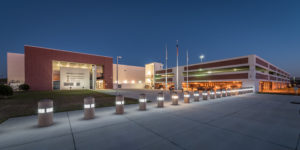 Emergency response to extreme events that impact public safety, both natural (tornadoes, hurricanes, earthquakes) and man-made (terrorism, train derailment) in the past several years has created a database of best practices and design guidelines for public safety facilities. The design of emergency communications and dispatch facilities / E-911 PSAPs have generally been guided by the National Fire Protection Association’s (NFPA) Standard for the Installation, Maintenance, and Use of Emergency Services Communications Systems (NFPA 1221).
Emergency response to extreme events that impact public safety, both natural (tornadoes, hurricanes, earthquakes) and man-made (terrorism, train derailment) in the past several years has created a database of best practices and design guidelines for public safety facilities. The design of emergency communications and dispatch facilities / E-911 PSAPs have generally been guided by the National Fire Protection Association’s (NFPA) Standard for the Installation, Maintenance, and Use of Emergency Services Communications Systems (NFPA 1221).
Additionally, industry support groups like APCO International and NENA (National Emergency Number Association) provide a large array of resources to assist the design, operation, and management of E-911 PSAPs. Emergency response has always been a critical part of public safety services, however, beginning with the terrorist attack of September 11th, followed by Hurricanes Charley and Katrina, FEMA and The Department of Defense (DOD) have promulgated guidelines to ensure the survivability and continued operations of PSAPs during and after catastrophic events. A large database of standards, guidelines and best practices are available for responsive facility design. Concurrently, social issues are impacting the design, management, and operations of the E-911 PSAP. Consolidation of 311 with E-911 is a direct result of societal trends.
Architects Design Group, the industry recognized expert in the specialized field of public safety facility design, continues to explore the impact of current and emerging trends to ensure our projects maximize value for the communities being served.